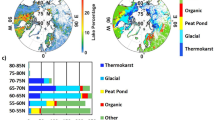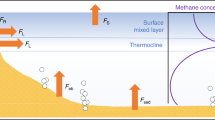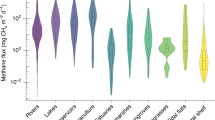Abstract
Lakes and ponds represent one of the largest natural sources of the greenhouse gas methane. By surface area, almost half of these waters are located in the boreal region and northwards. A synthesis of measurements of methane emissions from 733 lakes and ponds north of ∼50° N, combined with new inventories of inland waters, reveals that emissions from these high latitudes amount to around 16.5 Tg CH4 yr−1 (12.4 Tg CH4-C yr−1). This estimate — from lakes and ponds alone — is equivalent to roughly two-thirds of the inverse model calculation of all natural methane sources in the region. Thermokarst water bodies have received attention for their high emission rates, but we find that post-glacial lakes are a larger regional source due to their larger areal extent. Water body depth, sediment type and ecoclimatic region are also important in explaining variation in methane fluxes. Depending on whether warming and permafrost thaw cause expansion or contraction of lake and pond areal coverage, we estimate that annual water body emissions will increase by 20–54% before the end of the century if ice-free seasons are extended by 20 days. We conclude that lakes and ponds are a dominant methane source at high northern latitudes.
This is a preview of subscription content, access via your institution
Access options
Subscribe to this journal
Receive 12 print issues and online access
$259.00 per year
only $21.58 per issue
Buy this article
- Purchase on Springer Link
- Instant access to full article PDF
Prices may be subject to local taxes which are calculated during checkout




Similar content being viewed by others
References
Kirschke, S. et al. Three decades of global methane sources and sinks. Nature Geosci. 6, 813–823 (2013).
Lehner, B. & Döll, P. Development and validation of a global database of lakes, reservoirs and wetlands. J. Hydrol. 296, 1–22 (2004).
Downing, J. A. et al. The global abundance and size distribution of lakes, ponds, and impoundments. Limnol. Oceanogr. 51, 2388–2397 (2006).
Smith, L. C., Sheng, Y. & MacDonald, G. M. A first pan-Arctic assessment of the influence of glaciation, permafrost, topography and peatlands on Northern Hemisphere lake distribution. Permafrost Periglac. 18, 201–208 (2007).
Bruhwiler, L. et al. CarbonTracker-CH4: an assimilation system for estimating emissions of atmospheric methane. Atmos. Chem. Phys. 14, 8269–8293 (2014).
Walter, K. M., Smith, L. C. & Stuart Chapin, F. Methane bubbling from northern lakes: present and future contributions to the global methane budget. Phil. Trans. R. Soc. A 365, 1657–1676 (2007).
Bastviken, D., Tranvik, L. J., Downing, J. A., Crill, P. M. & Enrich-Prast, A. Freshwater methane emissions offset the continental carbon sink. Science 331, 50–50 (2011).
Tan, Z. & Zhuang, Q. Arctic lakes are continuous methane sources to the atmosphere under warming conditions. Environ. Res. Lett. 10, 1–9 (2015).
Verpoorter, C., Kutser, T., Seekell, D. A. & Tranvik, L. J. A global inventory of lakes based on high-resolution satellite imagery. Geophys. Res. Lett. 41, 6396–6402 (2014).
Sepulveda-Jauregui, A., Walter Anthony, K. M., Martinez-Cruz, K., Greene, S. & Thalasso, F. Methane and carbon dioxide emissions from 40 lakes along a north–south latitudinal transect in Alaska. Biogeosciences 12, 3197–3223 (2015).
Greene, S., Walter Anthony, K. M., Archer, D., Sepulveda-Jauregui, A. & Martinez-Cruz, K. Modeling the impediment of methane ebullition bubbles by seasonal lake ice. Biogeosciences 11, 6791–6811 (2014).
Collins, M. et al. in Climate Change 2013: The Physical Science Basis (eds Stocker, T. F. et al.) 1029–1136 (IPCC, Cambridge Univ. Press, 2013).
Schuur, E. A. G. et al. Climate change and the permafrost carbon feedback. Nature 520, 171–179 (2015).
Schneider, P. & Hook, S. J. Space observations of inland water bodies show rapid surface warming since 1985. Geophys. Res. Lett. 37, L22405 (2010).
Dibike, Y., Prowse, T., Saloranta, T. & Ahmed, R. Response of Northern Hemisphere lake-ice cover and lake-water thermal structure patterns to a changing climate. Hydrol. Process. 25, 2942–2953 (2011).
Wik, M. et al. Energy input is primary controller of methane bubbling in subarctic lakes. Geophys. Res. Lett. 41, 555–560 (2014).
Thornton, B. F., Wik, M. & Crill, P. M. Climate-forced changes in available energy and methane bubbling from subarctic lakes. Geophys. Res. Lett. 42, 1936–1942 (2015).
Prowse, T. D. & Stephenson, R. L. The relationship between winter lake cover, radiation receipts and the oxygen deficit in temperate lakes. Atmos. Ocean 24, 386–403 (1986).
Rouse, W. R. et al. Effects of climate change on the freshwaters of Arctic and subarctic North America. Hydrol. Process. 11, 873–902 (1997).
Natchimuthu, S., Panneer Selvam, B. & Bastviken, D. Influence of weather variables on methane and carbon dioxide flux from a shallow pond. Biogeochemistry 119, 403–413 (2014).
Zeikus, J. G. & Winfrey, M. R. Temperature limitation of methanogenesis in aquatic sediments. Appl. Environ. Microbiol. 31, 99–107 (1976).
Kelly, C. A. & Chynoweth, D. P. The contributions of temperature and of the input of organic matter in controlling rates of sediment methanogenesis. Limnol. Oceanogr. 26, 891–897 (1981).
Yvon-Durocher, G. et al. Methane fluxes show consistent temperature dependence across microbial to ecosystem scales. Nature 507, 488–491 (2014).
Martens, C. S. & Val Klump, J. Biogeochemical cycling in an organic-rich coastal marine basin—I. Methane sediment–water exchange processes. Geochim. Cosmochim. Acta 44, 471–490 (1980).
Bastviken, D., Cole, J., Pace, M. & Tranvik, L. Methane emissions from lakes: dependence of lake characteristics, two regional assessments, and a global estimate. Glob. Biogeochem. Cycles 18, GB4009 (2004).
Walter Anthony, K. M. & Anthony, P. Constraining spatial variability of methane ebullition seeps in thermokarst lakes using point process models. J. Geophys. Res. Biogeosci. 118, 1–20 (2013).
Rasilo, T., Prairie, Y. T. & del Giorgio, P. A. Large-scale patterns in summer diffusive CH4 fluxes across boreal lakes, and contribution to diffusive C emissions. Glob. Change Biol. 21, 1124–1139 (2014).
Wik, M., Crill, P. M., Varner, R. K. & Bastviken, D. Multiyear measurements of ebullitive methane flux from three subarctic lakes. J. Geophys. Res. Biogeosci. 118, 1307–1321 (2013).
Tranvik, L. J. et al. Lakes and reservoirs as regulators of carbon cycling and climate. Limnol. Oceangr. 54, 2298–2314 (2009).
Schuur, E. A. G. et al. Expert assessment of vulnerability of permafrost carbon to climate change. Climatic Change 119, 359–374 (2013).
Avis, C. A., Weaver, A. J. & Meissner, K. J. Reduction in areal extent of high-latitude wetlands in response to permafrost thaw. Nature Geosci. 4, 444–448 (2011).
van Huissteden, J. et al. Methane emissions from permafrost thaw lakes limited by lake drainage. Nature Clim. Change 1, 119–123 (2011).
Bouchard, F., Francus, P., Pienitz, R., Laurion, I. & Feyte, S. Subarctic thermokarst ponds: investigating recent landscape evolution and sediment dynamics in thawed permafrost of northern Québec (Canada). Arct. Antarct. Alp. Res. 46, 251–271 (2014).
Peterson, B. J. Trajectory shifts in the Arctic and subarctic freshwater cycle. Science 313, 1061–1066 (2006).
McClelland, J. W., Déry, S. J., Peterson, B. J., Holmes, R. M. & Wood, E. F. A pan-Arctic evaluation of changes in river discharge during the latter half of the 20th century. Geophys. Res. Lett. 33, L06715 (2006).
Boereboom, T., Depoorter, M., Coppens, S. & Tison, J. L. Gas properties of winter lake ice in northern Sweden: implication for carbon gas release. Biogeosciences 9, 827–838 (2012).
Petrescu, A. M. R. et al. Modeling regional to global CH4 emissions of boreal and Arctic wetlands. Glob. Biogeochem. Cycles 24, 1–12 (2010).
Melton, J. R. et al. Present state of global wetland extent and wetland methane modelling: conclusions from a model inter-comparison project (WETCHIMP). Biogeosciences 10, 753–788 (2013).
Houweling, S., Kaminski, T., Dentener, F. J., Lelieveld, J. & Heimann, M. Inverse modeling of methane sources and sinks using the adjoint of a global transport model. J. Geophys. Res. 104, 26137–26160 (1999).
Krol, M. Can the variability in tropospheric OH be deduced from measurements of 1,1,1-trichloroethane (methyl chloroform)? J. Geophys. Res. 108, 4125 (2003).
Bousquet, P., Hauglustaine, D. A., Peylin, P., Carouge, C. & Ciais, P. Two decades of OH variability as inferred by an inversion of atmospheric transport and chemistry of methyl chloroform. Atmos. Chem. Phys. 5, 2635–2656 (2005).
Montzka, S. A. et al. Small interannual variability of global atmospheric hydroxyl. Science 331, 67–69 (2011).
Downing, J. Emerging global role of small lakes and ponds: little things mean a lot. Limnetica 29, 9–24 (2010).
Whitfield, C. J., Baulch, H. M., Chun, K. P. & Westbrook, C. J. Beaver-mediated methane emission: the effects of population growth in Eurasia and the Americas. AMBIO 44, 7–15 (2015).
Hartmann, D. L. et al. in Climate Change 2013: The Physical Science Basis (eds Stocker, T. F. et al.) 159–254 (IPCC, Cambridge Univ. Press, 2013).
MacIntyre, S. et al. Climate-related variations in mixing dynamics in an Alaskan Arctic lake. Limnol. Oceanogr. 54, 2401–2417 (2009).
Schnurrenberger, D., Russell, J. & Kelts, K. Classification of lacustrine sediments based on sedimentary components. J. Paleolimnol. 29, 141–154 (2003).
McGinnis, D. F., Greinert, J., Artemov, Y., Beaubien, S. E. & Wüest, A. Fate of rising methane bubbles in stratified waters: how much methane reaches the atmosphere? J. Geophys. Res. 111, C09007 (2006).
Phelps, A. R., Peterson, K. M. & Jeffries, M. O. Methane efflux from high-latitude lakes during spring ice melt. J. Geophys. Res. 103, 29029–29036 (1998).
Laurion, I. et al. Variability in greenhouse gas emissions from permafrost thaw ponds. Limnol. Oceanogr. 55, 115–133 (2010).
Sellmann, P. V., Brown, J., Lewellen, R. I., McKim, H. & Merry, C. The Classification and Geomorphic Implications of Thaw Lakes on the Arctic Coastal Plain, Alaska Research Report 344 (Cold Regions Research and Engineering Laboratory, 1975).
Grosse, G., Jones, B. & Arp, C. Thermokarst lakes, drainage, and drained basins. Treat. Geomorph. 8, 325–353 (2013).
Grosse, G. et al. Distribution of Late Pleistocene Ice-Rich Syngenetic Permafrost of the Yedoma Suite in East and Central Siberia, Russia Open File Report 2013–1078 (USGS, 2013).
Strauss, J. et al. The deep permafrost carbon pool of the yedoma region in Siberia and Alaska. Geophys. Res. Lett. 40, 6165–6170 (2013).
Walter Anthony, K. et al. A shift of thermokarst lakes from carbon sources to sinks during the Holocene epoch. Nature 511, 452–456 (2014).
Walter, K. M., Zimov, S. A., Chanton, J. P., Verbyla, D. & Chapin, F. S. Methane bubbling from Siberian thaw lakes as a positive feedback to climate warming. Nature 443, 71–75 (2006).
Anthony, K. M. W., Anthony, P., Grosse, G. & Chanton, J. Geologic methane seeps along boundaries of Arctic permafrost thaw and melting glaciers. Nature Geosci. 5, 1–8 (2012).
Brosius, L. S. et al. Using the deuterium isotope composition of permafrost meltwater to constrain thermokarst lake contributions to atmospheric CH4 during the last deglaciation. J. Geophys. Res. 117, G01022 (2012).
Kessler, M. A., Plug, L. J. & Walter Anthony, K. M. Simulating the decadal- to millennial-scale dynamics of morphology and sequestered carbon mobilization of two thermokarst lakes in NW Alaska. J. Geophys. Res. 117, 1–22 (2012).
Bowen, R. G., Dallimore, S. R., Côte, M. M., Wright, J. F. & Lorenson, T. D. in Proceedings of Ninth International Conference on Permafrost (eds Kane, D. L. & Hinkel, K. M.) 171–176 (Institute of Northern Engineering, Univ. Alaska Fairbanks, 2008).
Manasypov, R. M., Pokrovsky, O. S., Kirpotin, S. N. & Shirokova, L. S. Thermokarst lake waters across the permafrost zones of western Siberia. Cryosphere 8, 1177–1193 (2014).
Tank, S. E., Lesack, L. F. W., Gareis, J. A. L., Osburn, C. L. & Hesslein, R. H. Multiple tracers demonstrate distinct sources of dissolved organic matter to lakes of the Mackenzie Delta, western Canadian Arctic. Limnol. Oceanogr. 56, 1297–1309 (2011).
Hinkel, K. M., Frohn, R. C., Nelson, F. E., Eisner, W. R. & Beck, R. A. Morphometric and spatial analysis of thaw lakes and drained thaw lake basins in the western Arctic Coastal Plain, Alaska. Permafrost Periglac. 16, 327–341 (2005).
Prowse, T. et al. Past and future changes in Arctic lake and river ice. AMBIO 40, 53–62 (2011).
Sharma, S. & Magnuson, J. J. Oscillatory dynamics do not mask linear trends in the timing of ice breakup for Northern Hemisphere lakes from 1855 to 2004. Climatic Change 124, 835–847 (2014).
Surdu, C. M., Duguay, C. R., Brown, L. C. & Fernández Prieto, D. Response of ice cover on shallow lakes of the North Slope of Alaska to contemporary climate conditions (1950–2011): radar remote-sensing and numerical modeling data analysis. Cryosphere 8, 167–180 (2014).
Smith, L. C., Sheng, Y., MacDonald, G. M. & Hinzman, L. D. Disappearing Arctic lakes. Science 308, 1429–1429 (2005).
Andresen, C. G. & Lougheed, V. L. Disappearing Arctic tundra ponds: fine-scale analysis of surface hydrology in drained thaw lake basins over a 65 year period (1948–2013). J. Geophys. Res. Biogeosci. 120, 466–479 (2015).
Kicklighter, D. W. et al. Insights and issues with simulating terrestrial DOC loading of Arctic river networks. Ecol. Appl. 23, 1817–1836 (2013).
Wetzel, G. R. Limnology: Lake and River Ecosystems (Academic, 2001).
Belyea, L. R. & Clymo, R. S. in Patterned Mires and Mire Pools: Origin and Development, Flora and Fauna (eds Standen, V., Tallis, J. & Meade, R.) 55–65 (British Ecological Society, 1999).
Gao, X. et al. Permafrost degradation and methane: low risk of biogeochemical climate-warming feedback. Environ. Res. Lett. 8, 035014 (2013).
Brown, J., Ferrians, O. J. J., Heginbottom, J. A. & Melnikov, E. S. Circum-Arctic Map of Permafrost and Ground-Ice Conditions (National Snow and Ice Data Center, 1998, revised February 2001); http://go.nature.com/JQIke5
Olson, D. M. et al. Terrestrial ecoregions of the world: a new map of life on Earth. BioScience 51, 933–938 (2001).
Peel, M. C., Finlayson, B. L. & McMahon, T. A. Updated world map of the Köppen-Geiger climate classification. Hydrol. Earth. Syst. Sci. 11, 1633–1644 (2007).
Chen, D. & Chen, H. W. Using the Köppen classification to quantify climate variation and change: an example for 1901–2010. Environ. Devel. 6, 69–79 (2013).
Acknowledgements
We thank the National Science Foundation (NSF) Vulnerability of Permafrost Carbon Research Coordination Network grant no. 955713 and the NSF Research, Synthesis, and Knowledge Transfer in a Changing Arctic: Science Support for the Study of Environmental Arctic Change grant no. 1331083 for support and ideas. Additional support came from the Climate in Cryosphere programme, a core project of the World Climate Research Programme, via the Permafrost Carbon Network. Financial support to M.W. was provided by the Department of Geological Sciences, Stockholm University and the Swedish Research Council (VR) grant no. 2007-4547 to Prof. P. Crill, and by the Nordic Center of Excellence DEFROST under the Nordic Top-Level Research Initiative. Financial support to S.M. was from U.S. NSF Awards ANS-1204267 and DEB 0919603. D.B. was supported by Linköping University and by grants from VR. We further thank P. Crill, B. Thornton and L. Bruhwiler for comments on the manuscript.
Author information
Authors and Affiliations
Contributions
M.W. compiled the database, made the analysis and figures, and wrote the manuscript. R.K.V. and K.W.A. contributed to the database compilation. R.K.V., K.W.A., S.M. and D.B. assisted in data analysis, interpretation and in writing the manuscript.
Corresponding author
Ethics declarations
Competing interests
The authors declare no competing financial interests.
Supplementary information
Supplementary Information
Supplementary Information (PDF 2005 kb)
Rights and permissions
About this article
Cite this article
Wik, M., Varner, R., Anthony, K. et al. Climate-sensitive northern lakes and ponds are critical components of methane release. Nature Geosci 9, 99–105 (2016). https://doi.org/10.1038/ngeo2578
Received:
Accepted:
Published:
Issue Date:
DOI: https://doi.org/10.1038/ngeo2578
This article is cited by
-
High methane ebullition throughout one year in a regulated central European stream
Scientific Reports (2024)
-
Diminishing lake area across the northern permafrost zone
Nature Geoscience (2023)
-
Tracking lake drainage events and drained lake basin vegetation dynamics across the Arctic
Nature Communications (2023)
-
Characteristics of methane emissions from alpine thermokarst lakes on the Tibetan Plateau
Nature Communications (2023)
-
Panarctic lakes exerted a small positive feedback on early Holocene warming due to deglacial release of methane
Communications Earth & Environment (2023)



